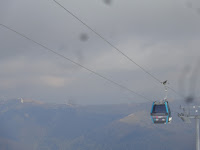A few weeks ago, I started getting my deliveries from abroad. One moving team I had were speaking a foreign language that seemed vaguely Slavic, so I asked them where they were from. After they told me they were from Romania, I told them I had just visited their country in the spring. They were thrilled when I evocatively described its capital and mountains. The revelation might have slightly made up for the lack of elevator to my third-floor apartment.
The men's national pride came as no surprise to me. Romania is full of history and charm. Hoping to avoid the weekend rush, I headed out of the capital my first weekday in country. I took a short train ride to Sinaia, a foothill town that has been a pilgrimage destination for years. About four centuries ago, the devout were drawn to the monastery (top left). From the church, a short, shady pathway is a perfect place for wedding photos (top right). The pedestrianized road leads uphill to Peles Castle, which turned the village into a royal playground in the 19th century (bottom left). Despite its extravagance, the palace has enough mountain-lodge details that it suits the setting (bottom right).
The refreshing surroundings are replicated in decorative panels in the grand hall, the first in Europe to have electricity (top left). Ironically, the extravagant amount of wood inside detracts from the nature outside, except when it's used for a secret door (top right). Although the castle has extensive pleasure grounds, it also afforded indoor entertainment, with a stained-glass-adorned music room (bottom left) and a theater that includes Klimt-painted borders (bottom right).Eventually, regular people -- well, the richer ones -- wanted the royal treatment, so the village became a resort featuring attractions for the masses, including a casino for balls and other receptions (top left) and Villa Caprita, a party venue owned by a lady-in-waiting of Queen Mary of Romania (top right). Nowadays, the city is a base for tourists of all classes who want to enjoy the nearby ski area. A new gondola was constructed in this century to meet growing demand (bottom left). On the day I was there, it was undergoing repairs, so I used the older cable car instead (bottom right).
The scenery on the ride up took away any lingering fears I had of the ski lift's safety record (top left). The slopes are contained with Bucegi National Park, which features a network of well-marked trails (top right). Unfortunately, I lost a lot of time finding the operational public transport, so I didn't get to hike a loop around the summit as I had hoped. Instead, I wandered around the ridges near the cable-car station, gawking at the even higher peaks in the distance (bottom).
I made up for my lack of hiking back in Bucharest, where I spent a lot of time walking around to sights. Tucked away just a short ways from my hosts' apartment was Ceausescu's Palace, which I decided not to tour because when you've seen one dictator's decadence at the expense of his people, you've seen them all (top). Still, in my wanderings, I hit most of the Ceausescu-related stops. From Revolution Square, home to the Memorial of Rebirth, I saw the balcony on the Ministry of Internal Affairs, where he gave his last speech before being spirited away in a helicopter (bottom left). Or, according to some spirited debate, perhaps it was from the balcony on the National Museum of Art across the street, which does look quite similar (bottom right).
There's definitely no mistaking the Palace of Parliament, the second-largest building in the world behind the Pentagon (top left). From that building, the country's spirit animal, Michael Jackson, once gave a speech in which he called the city Budapest instead of Bucharest. Despite the faux pas, he remains beloved, as indicated by a memorial in one of the city's largest parks (top right). It is named, not after the King of Pop, but King Mihai I Park, the last king of Romania (bottom left). Shrines to the country's final ruler have sprung up since his death in 2017 (bottom right).
Romanians are lovers of their own history, of course, but they appear to be Francophiles as well. A replica of the Arc de Triumph sits amid one of the main boulevards downtown (top left). An awning over the entrance to the Enescu Museum, in honor of the country's most notable composer, is art nouveau at its finest (top right). The capital, of course, retains its own urban style, in which modernist materials mix with ivy-encroached edifices (bottom left). And like many European cities, it's embracing street art as part of efforts to combat graffiti (bottom right).
If my visit to the National Village Museum is any indication, the country has long incorporated color into its architecture (top left). The open-air collection of houses and other structures from various regions and time periods is one of the best "museums" I've ever been to (top right). When it's not overrun by student groups, it's a peaceful park to linger in for a picnic or a read. And if you are interested in exploring the culture, you can pop inside the buildings that are open to the public (bottom).
Bibliophile that I am, I was most excited to enter the Carturesti Bookstore, a downtown institution that has transformed its iconic interior into a welcoming temple to tomes (top). I couldn't help but buy a novel by a Romanian-born recipient of the 2009 Nobel Prize in Literature, Herta Muller. A few blocks away, at Romanian Craft Beer Bar, I also managed to take in a sample of one of my other loves, a Zaganu Rosie Red Ale (bottom left). But if I had to pick the one Romanian item that really fed my soul, I'd have to go with papanasi, a traditional dish of donuts smothered in jam and cream (bottom right).
































No comments:
Post a Comment